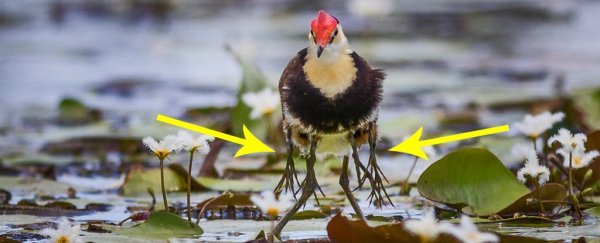The photo above is not depicting some ten-legged mutant bird as some of our Instagram commenters have suggested. It's also not one of those hilarious birds with arms memes.
He's just one brave daddy bird hauling his four chicklings to safety.
Comb-crested Jacanas (Irediparra gallinacea) are also known as lillytrotters or Jesus-birds for their ability to seemingly walk across water. Their gangly legs end in long twiggy-toes, splayed wide to distribute their weight across the surface of lily pads and the other floating plants they walk on.
This allows the water plants to keep these 20 to 27 centimetre (8 to 11 inch) birds afloat as they dart across the surface of their wetland habitats.
Here, they search for their favourite foods, mostly freshwater invertebrates such as aquatic moth larvae, and aquatic plant seeds, particularly lily seeds.
 (DirkKotze1/iStock)
(DirkKotze1/iStock)
Sally Corte from Queensland, Australia captured the jacana pictured in the cover and in the image below, as it was displaying this species' unique parenting behaviour.
"I was lucky to be in my canoe, quietly removing by hand the water weed called Salvinia, when I saw a jacana with some chicks trailing behind," Corte told ScienceAlert in an email.
"Although common, they are quite shy and very wary, making capturing them on camera difficult."
After she'd run back to get her camera, the chicks were gone, so she snapped an image of just the adult.
It wasn't until Corte processed the images she was lucky enough to snap that she realised: "there were actually 8 dangling legs!"

(Sally Corte/CorteOnCamera)
Comb-crested jacana dads literally pick up their babies with their wings to carry them to safety. Considering up to 80 percent of nests can be lost before they hatch, it's no wonder they'll do everything in their power to save their precious chicks from any potential threats.
There have also been claims they relocate their eggs by carrying them under their chin.
These jacanas can be found in wetlands from Borneo, though to New Guinea and Australia's north and east coast to the Canberra area.
Back in 2000, ornithologist Terrence Mace's study on this species mating system found these birds are polyandrous, meaning the larger female jacanas mate with more than one male - between 2-3 males on average.
After laying their eggs on floating nests, female jacanas often fly off for fun times with another lover, leaving their mate with full responsibility for incubating these quite strikingly patterned eggs all by themselves.
The males then become the sole carers for the awkward floofs on stilts once they've hatched.
Mace believes this unusual mating strategy may have evolved due to their high rate of clutch loss - the more eggs laid, the greater the chance some birds might make it.
 (Sally Corte/CorteOnCamera)
(Sally Corte/CorteOnCamera)
Corte explained how the jacanas are one of the permanent residents amongst an ever shifting population of wetland birds on her property's freshwater dam in Queensland.
"Some birds appear occasionally, like the black-necked stork and brolgas and others are seasonal daily visitors such as magpie geese and whistling ducks," she said.
As with too many of our wildlife around the world, these birds are threatened by the usual suspects, including the destruction of their amazing wetland habitats and predation by feral animals like foxes. Comb-crested jacanas are listed as vulnerable in the Australian state of New South Wales.
 (Sally Corte/CorteOnCamera)
(Sally Corte/CorteOnCamera)
"I've witnessed other male jacanas sheltering their chicks in the same way from rain," Corte told us. "What awesome dads!"
